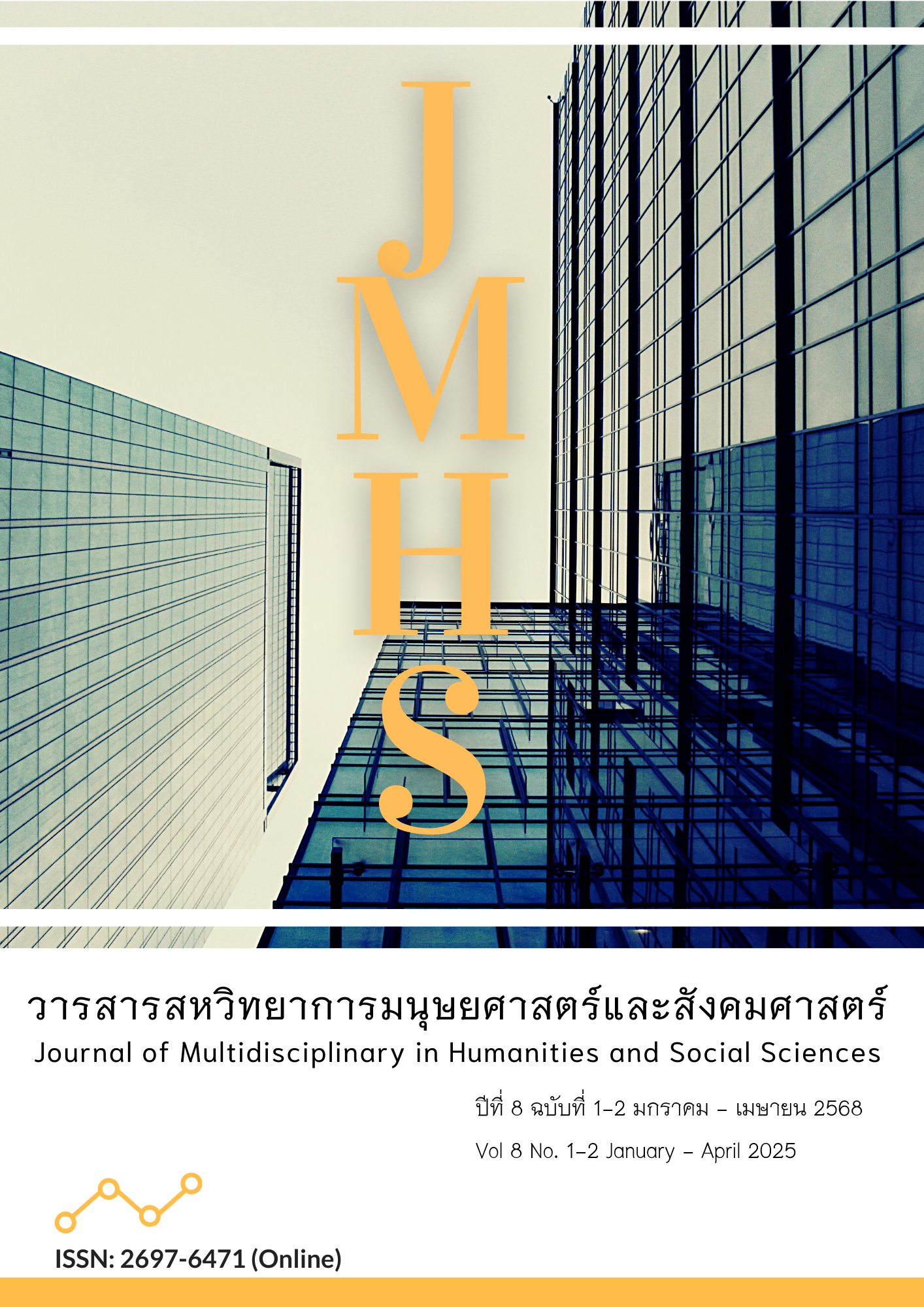Influence of Antecedents on Repurchasing Intentions toward Perception Capability and Response Capability of Traditional Trade of the Business-to-Business (B2B) Market in the Northeastern Region of Thailand
Main Article Content
Abstract
Modern trade in the form of discount stores or hypermarkets are rapidly expanding their regional branches to enhance their business-to-business (B2B) supply chain with traditional trade. This requires local distributors to find ways to maintain the customer base of traditional trade in the area. The article aimed to 1) study the causal influence of information sharing and customer relationship management toward perception capability and response capability on repurchasing intentions of traditional trade of the business-to-business (B2B) market in the northeastern region of Thailand; and 2) study the causal influence of structural equation modeling in qualitative research to support objective 1. The mixed-methods research technique was used. The first was quantitative research. The sample population consisted of 792 owners or representatives at traditional trade obtained by using the technique of multi-stage sampling. A questionnaire was used to collect data. Data were analyzed using descriptive and inferential statistics. The second was qualitative research with 15 owners at traditional trade obtained by purposive sampling. Data was inductively analyzed.
The research revealed that 1) the structural equation model consisted of information sharing, customer relationship management, perception capability, response capability, and repurchasing intentions; 2) the model exhibited congruence with empirical data with χ2/df = 1.17, p-value = 0.07, and RMSEA = 0.00, and this could be explanatory of the variance of repurchasing intentions at 93 percent; and 3) qualitative research findings supported all the hypotheses of the quantitative research.
Article Details

This work is licensed under a Creative Commons Attribution-NonCommercial-NoDerivatives 4.0 International License.
Views and opinions appearing in the Journal it is the responsibility of the author of the article, and does not constitute the view and responsibility of the editorial team.
References
กรมพัฒนาธุรกิจการค้า. (1 มกราคม 2568). Datawarehouse: ข้อมูลรายพื้นที่: ภาคตะวันออกเฉียงเหนือ, สืบค้นเมื่อ 21 มกราคม 2568, จาก https://datawarehouse.dbd.go.th/area/overview
กัลยา วานิชย์บัญชา. (2556). การวิเคราะห์สถิติ: สถิติสาหรับการบริหารและวิจัย. (พิมพ์ครั้งที่ 14). กรุงเทพมหานคร: จุฬาลงกรณ์มหาวิทยาลัย.
นรินทร์ ตันไพบูลย์. (4 เมษายน 2567). วิจัยกรุงศรี: แนวโน้มธุรกิจ/อุตสาหกรรมปี 2567-2569: ธุรกิจร้านค้าปลีกสมัยใหม่. สืบค้นเมื่อ 9 มกราคม 2568, จาก https://www.krungsri.com/th/research/industry/industry-outlook/wholesale-retail/modern-trade/io/modern-trade-2024-2026
พีระพัฒน์ ยวงสุวรรณ และ สมชาย เล็กเจริญ. (2567). ปัจจัยเชิงสาเหตุที่มีผลต่อความตั้งใจใช้บริการเช่าเครื่องแต่งกายบนเพจเฟซบุ๊กละมุนนี ของผู้บริโภคในกรุงเทพมหานครและปริมณฑล. วารสารสหวิทยาการมนุษยศาสตร์และสังคมศาสตร์, 7(6), 3501-3518. สืบค้นจาก
https://so04.tci-thaijo.org/index.php/jmhs1_s/article/view/271800
สุชาติ ประสิทธิ์รัฐสิทธุ์. (2555). ระเบียบวิธีการวิจัยทางสังคมศาสตร์. (พิมพ์ครั้งที่ 15). กรุงเทพมหานคร: สามลดา.
สุดา ตอแก้ว และ เจษฎา วงศ์แสนสุขเจริญ. (2566). การจัดการลูกค้าสัมพันธ์ คุณภาพการบริการและการรับรู้คุณค่าตราสินค้า ที่ส่งผลต่อความภักดีของลูกค้าในอุตสาหกรรมอิเล็กทรอนิกส์เขตเศรษฐกิจพิเศษภาคตะวันออก. Journal of Modern Learning Development, 8(7), 373-382. สืบค้นจาก https://so06.tci-thaijo.org/index.php/jomld/article/view/260690/178465
สำนักบริหารการทะเบียน: กรมการปกครอง: กระทรวงมหาดไทย. (1 มกราคม 2567). สถิติประชากรทางการทะเบียนราษฎร. สืบค้นเมื่อ 8 มกราคม 2568, จาก https://stat.bora.dopa.go.th/stat/statnew/statMONTH/statmonth/#/mainpage
ศูนย์วิจัยกสิกรไทย. (23 ธันวาคม 2567). ค้าปลีกปี 2568 คาดโต 3.0% แต่ผู้ประกอบการยังเสี่ยงแข่งขันรุนแรงและต้นทุนเพิ่ม. สืบค้นเมื่อ 8 มกราคม 2568, จาก
Adela, M., & Tuti, M. (2024). Increasing Customer Repurchasing Intentions: The Significance of Product Quality, Viral Marketing, and Customer Experience. APTISI Transactions on Management (ATM), 8(2), 105-114. https://doi.org/:10.33050/atm.v8i2.2263
Chen, B., Liu, J., Maimaiti, M., Gao, X., & Zhang, J. (2022). Generating persuasive responses to customer reviews with multi-source prior knowledge in e-commerce. In Proceedings of the 31st ACM International Conference on Information & Knowledge Management, Atlanta, GA, USA, October 17-21, 2022, 2994-3002. https://doi.org/10.1145/3511808.3557122
D'Arconte, C. (1 December 2023). Customer Relationship Management (CRM): A conceptualization based on strategy to integrate different perspectives. Retrieved January 2, 2025, from https://www.researchgate.net/publication/376398581_Customer_Relationship_
Management_CRM_a_conceptualization_based_on_strategy_to_integrate_different_perspectives
Dervin, B., Harlock, S., Atwood, R., & Garzona, C. (1980). The human side of information: an exploration in a health communication context. Annals of the International Communication Association, 4(1), 591-608. https://doi.org/10.1080/23808985.1980.11923827
Haase, J., & Wiedmann, K. P. (2020). The implicit sensory association test (ISAT): A measurement approach for sensory perception. Journal of Business Research, 109(C), 234-245. https://doi.org/10.1016/j.jbusres.2019.12.005
Hair, J., Black, W., Babin, B., Anderson, R., & Tatham, R. (2006). Multivariate data analysis. (6th ed.). New Jersey: Pearson Prentice Hall.
Lamonaca, E., Cafarelli, B., Calculli, C., & Tricase, C. (2022). Consumer perception of attributes of organic food in Italy: A CUB model study. Heliyon, 8(3), e09007. https://doi.org/10.1016/j.heliyon.2022.e09007
Lee, C., & Kim, S. (2023). Impact of information sharing on trust and commitment level in the supply chain: Focus on Korea’s three new core industries. Operations and Supply Chain Management, 16(1), 17-25. https://doi.org/10.31387/oscm0520369
Leischnig, A., Kasper-Brauer, K., & Thornton, S.C. (2020). Configuring effective client-adviser interactions. Journal of Business Research, 115(4), 234–240. https://doi.org/10.1016/j.jbusres.2019.10.027
Lu, F. (2024). Online shopping consumer perception analysis and future network security service technology using logistic regression model. PeerJ Computer Science, 10, e1777. https://doi.org/10.7717/peerj-cs.1777
Masele, J. J. (2021). Information sharing in the social media era: a user in African perspective. University of Dar es Salaam Library Journal, 16(2), 202-222. https://doi.org/10.4314/udslj.v16i2.14
Prakoso, B., Hurriyati, R., & Hendrayati, H. (2024). The effective customer relationship management of business to business in improving customer satisfaction and customer retention. In Proceedings of the 8th Global Conference on Business, Management, and
Entrepreneurship (GCBME 2023), 638-644. https://doi.org/10.2991/978-94-6463-443-3_83
Prasanth, V. S., Kiran, N., & Datta, S. S. (2021). Customers perception with reference to customer relationship management in organized retail in Visakhapatnam. Turkish Journal of Computer and Mathematics Education (TURCOMAT), 12(10), 4350-4356. Retrieved from https://turcomat.org/index.php/turkbilmat/article/view/5167
Rovinelli, R.J., & Hambleton, R.K. (1977). On the use of content specialists in the assessment of criterion referenced test item validity. Dutch Journal of Educational Research, 2, 49-60.
Shukri, S.M., Yajid, M.S.A., & Tham, J. (2020). Role of responsiveness, reliability and tangibility on customer satisfaction. Systematic Reviews in Pharmacy, 11(1), 1007-1013. https://doi.org/10.5530/srp.2020.1.127


